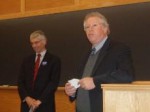The ABCs of Gender in Education
It’s the first day of school. You’re walking through the big double doors and down the cramped, bustling hallways. You’ve arrived at the classroom and as you enter, a sea of bright-eyed, piggy tail girls stares at you. And there you stand with your buzz cut and slowly growing facial hair. Feel out of place? You’ve just walked into a growing phenomenon of single-sex classrooms.
According to the National Association for Single-Sex Public Education (NASSPE), the United States has seen a growth from 1998’s four public schools that offered single-sex classroom options to 223 in April 2006. Of those, 44 are entirely gender-separated.
X and Y
Although test results show that boys and girls entering kindergarten perform close to equally, by third grade, the gender gap begins to noticeably show.
Since the 1970s, the National Assessment of Educational Progress (NAEP) has tracked students’ scores in reading, math and science. According to the NAEP’s long-term trend report, girls have continued to outscore boys in reading. In 1971, 17-year-old females outscored males 291 to 279. In 2004, for the same age group, girls scored 292 and boys were at 278. However, in mathematics, boys have continued to outscore girls. For 9-year olds, males scored 220 in 1973 and 243 in 2004 while females were at 218 and 240 respectively.
“It’s true. I score better in English than the other two (science and math) but I don’t know why,” said female Castleton student Jay Ette, 18.
As suggested by a report by the American Psychological Association, these differences can be contributed to biological factors, mainly brain structure and sex hormones. NASSPE supports this theory and proposes that different learning styles are developed due to the genetic differences.
“I think it depends on the particular person and how their mind works,” said Christine Cook, a 22-year-old English major.
But, some believe that even much more is involved.
“In my experience, differences in test scores is not gender-based,” said Castleton Psychology Professor Gail Regan.
“Test scores, generally, not in a particular subject, are a result of so many things: intelligence, investment of time and energy, number of study hours, family attitude about school, etc.,” she said.
Boys, Get Out
Now, the question: How to deal with this chromosomal problem? The answer seems to more commonly be single-sex classrooms.
An article titled “The Why Chromosome: How a Teacher’s Gender Affects Boys and Girls” that appeared in the fall 2006 issue of Education Next, states that “simply put, girls have better educational outcomes when taught by women and boys are better off when taught by men.” The piece was written by Thomas Dee, an associate professor of economics at Swarthmore College, and was based on his research paper, “Teachers and the gender gaps in student achievement.”
Previously, theories about the gender gap had been based on information about teachers and students in college, but resulted in mixed findings. However, Dee’s study focused on 9- to 17-year olds, when students are more responsive to gender differences.
Concentrating on science, social studies and English, Dee’s research found that girls who have a woman teacher raise their achievement by four percent of a standard deviation. When boys have a woman teacher, their percent decreases by approximately the same.
For girls with a same gendered teacher, benefits were mainly concentrated in social studies with a nine percent increase. However, boys with a female teacher suffered the largest effect of a five percent decrease in science.
“The goal was simply to examine. The key thing is that it demonstrates that something is going on,” said Dee of the three-year long analysis in a phone interview. “We need to try to understand what that is and if we understand it better, we can raise the achievements of both girls and boys. I hope this stimulates further inquires.”
According to an April 2006 article that appeared on National Education Association’s Web site, only 37 percent of boys in co-ed classes at Woodward Elementary in DeLand, Fla. passed a state writing test in 2005. In all-male classes, 86 percent passed.
“I think it adds a little bit of comfort. I know from my experiences growing up that I related to female teachers more. Male teachers wanted to make sure it was ok, come talk to me. And the same thing for the male students. They would go to a male teacher before going to a female,” said Cook, the 22-year old female Castleton English major.
However, some students don’t see any changes between having a same gendered teacher or not.
“I don’t think it really makes a difference,” said Ette. “At least for me it doesn’t.”
And still others believe they learn better from the opposite gender.
“I learn better from women professors,” said Chris Mack, 22. “I think the opposite sex is better because you listen better.”
Professor Lois Wunderley sees an opportunity for students to try new things not normally associated with their gender. For example, getting boys to try theater and music.
“I think that there are a number of positive factors. It encourages students to focus on academics and broadens participation in extracurricular activities traditionally dominated by the opposite sex,” she said.
College Bound
Dee’s research does not look into single sex education in colleges. Nor does he consider the effects that these classrooms have on students and their interactions once they reach college or the “real world.”
“They probably don’t know how to handle it. It’s probably a shock and takes some getting use to,” said Ette of students’ first experiences in co-ed classes.
Both Cook and Regan agree.
“They’re going to have to learn how to work together sooner or later,” said Cook. “They’re not given the chance to develop and mature when it relates to working with one another.”
“The real world will call for the ability to relate to the other gender. If we can help students understand more about how their peers, same-sex or opposite, view the world, that is better than no exposure to the other gender,” said Regan.
Discrimination?
“I’m not encouraging single-sex schools,” said Dee in defense of his study. “That has been a point of confusion. I’m merely trying to find out what’s really going on.”
Discrimination issues concerning the research have been brought up, especially by the National Women’s Law Center (NWLC).
“The proposed single-sex regulations allow and even encourage harmful sex-stereotyping and authorize a separate and unequal education system in our public schools for girls in the guise of enhanced flexibility,” said Marcia D. Greenberger, NWLC Co-President, in a 2004 press release.
The press release stated that the proposal to expand single-sex education would violate Title IX and the U.S. Constitution. Also, the NWLC commented that historically, all female programs have received fewer resources and opportunities.
Dee however doesn’t feel that discrimination will be an issue. Rather, it might already, inadvertently, be one and be a cause of the gender gap.
“Teachers unintentionally have a bias,” said Dee. “When a boy raises his hand and is called on (by a male teacher), the teacher is more likely to encourage and praise him even if he’s wrong. When a girl raises her hand, she is less likely to be encouraged.”
Ette believes that such an action is not discrimination, but might lead to it. Meanwhile, Cook thinks that in general, students should remain grouped together.
“It is just basically side-stepping an issue that will have to be dealt with sooner or later,” she said.






